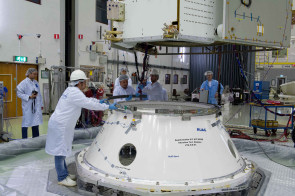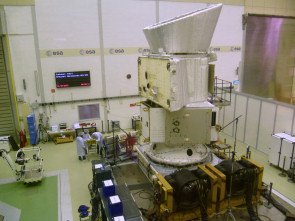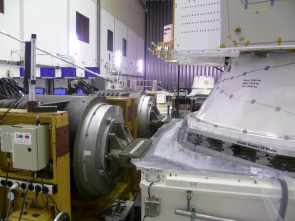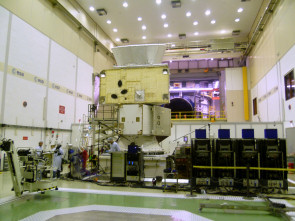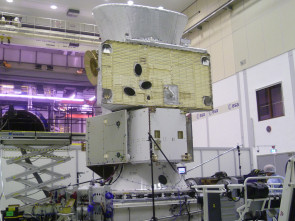#08: BepiColombo Composite Spacecraft Vibration Testing
17 August 2012
The BepiColombo Structural and Thermal Model test campaign has passed another milestone with the completion of sine vibration testing at qualification level along all three spacecraft axes.| BepiColombo Mercury Composite Spacecraft undergoing Z-axis vibration testing. Credit: ESA (For larger versions of this video click here) |
One of the design drivers for any space mission is the severe mechanical and acoustic environment to which a spacecraft is exposed during launch. Ensuring that every subsystem will maintain nominal performance after this exposure is an important part of every test campaign. The Structural and Thermal Model (STM) of the BepiColombo Mercury Composite Spacecraft (MCS), the configuration in which the spacecraft will launch and travel to Mercury, has now passed the series of tests relating to vibration. The tests were conducted using specialist equipment at ESA's European Space Research and Technology Centre (ESTEC) in Noordwijk, the Netherlands.
Z-axis test
Sinusoidal vibration testing along the Z-axis of the spacecraft stack, which is vertical in both the launch and test configurations, was performed in early July using the ESTEC Test Centre QUAD shaker. This is the most powerful electrodynamic shaker at ESTEC and consists of a 3.3 × 3.3-metre magnesium alloy 'head expander' or table, fitted on top of four 160 kN electrodynamic exciters that move the table up and down. The QUAD shaker is capable of producing sinusoidal accelerations of up to 20 g with a test item mass of up to 10 000 kg and can operate over the frequency range 3 Hz to 2 kHz.
As was the case with previous mechanical tests, the MCS was craned from its Multi-Purpose Trolley (MPT) onto the shaker table, where its Vibration Test Adapter (VTA) had already been mounted, without the sunshield attached. This allows access to the lifting points on the Mercury Planetary Orbiter (MPO); the topmost element of the stack, the Mercury Magnetospheric Orbiter (MMO), is designed to be lifted alone, not as a structural element of the MCS stack. The sunshield was re-attached before the tests commenced.
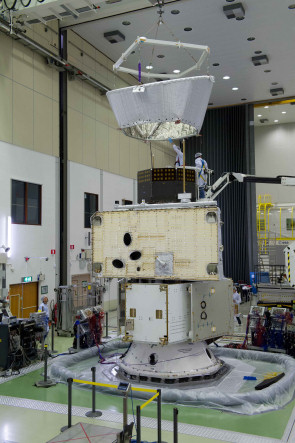 |
 |
| Replacing the sunshield on the BepiColombo Mercury Composite Spacecraft. Credit: ESA | BepiColombo Mercury Composite Spacecraft on the QUAD shaker. Credit: ESA |
The MCS was fitted with accelerometers at important points on its structure, to measure the displacements induced by the vibrations. The first test run was conducted at a low vibration level and spanned the frequency range from 3 Hz to 100 Hz; this low-level test was used to detect unexpected resonances that might cause damage at qualification level. With this successfully completed, a test from 5 Hz to 100 Hz at qualification level was conducted.
X- and Y-axis tests
Sinusoidal vibration testing along the X- and Y-axes of the spacecraft stack, which lie in the horizontal plane in both the launch and test configurations, was performed in late July using the ESTEC Test Centre Multishaker. This consists of a slip table, onto which the spacecraft under test is mounted, and a pair of 160 kN electrodynamic exciters that vibrate the table and spacecraft. The Multishaker is capable of producing sinusoidal accelerations of up to 19 g with a test item mass of up to 10 000 kg and can operate over the frequency range 3 Hz to 2 kHz.
| BepiColombo Mercury Composite Spacecraft undergoing X-axis vibration testing. Credit: ESA (For larger versions of this video click here) |
The X- and Y-axis testing was essentially a repeat of the process used for the Z-axis tests, with the spacecraft stack being rotated through 90° after one cycle of testing to address the second axis.
Further mechanical testing
The MCS will go on to be tested in the Large European Acoustic Facility (LEAF) at ESTEC. Here, it will be subjected to the acoustic environment it will experience due to the noise of the launcher engines and the airflow passing over the fairing that protects it during the atmospheric phase of its journey into space.
More tests will be conducted to ensure that the MCS can withstand the various mechanical shocks it will experience during its journey to Mercury. These shocks include that caused by the separation of the Mercury Transfer Module (MTM) from the MPO/MMO composite as they approach their target, the MPO/MMO separation shock in Mercury orbit and the shocks that are induced as the various spacecraft in the stack deploy appendages such as solar arrays and antennas.
About BepiColombo
BepiColombo is Europe's first mission to Mercury. It is scheduled to launch in August 2015 and arrive at Mercury in January 2022. It will endure temperatures in excess of 350 °C and gather data during a one-year nominal mission, with a possible one-year extension. The mission comprises two spacecraft: the Mercury Planetary Orbiter (MPO) and the Mercury Magnetospheric Orbiter (MMO). During the journey to Mercury, the MMO will be shielded from the Sun by the Magnetospheric Orbiter Sunshield and Interface Structure (MOSIF), which also provides the interface between the MMO and the MPO. The fourth component of the composite spacecraft stack is the Mercury Transfer Module (MTM), whose primary task is to provide solar-electric propulsion for the journey to Mercury.
BepiColombo is a joint mission by ESA and the Japan Aerospace Exploration Agency (JAXA), executed under ESA leadership. The Prime Contractor for BepiColombo is Astrium GmbH.


